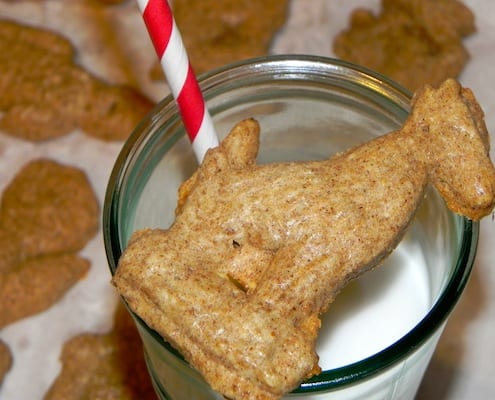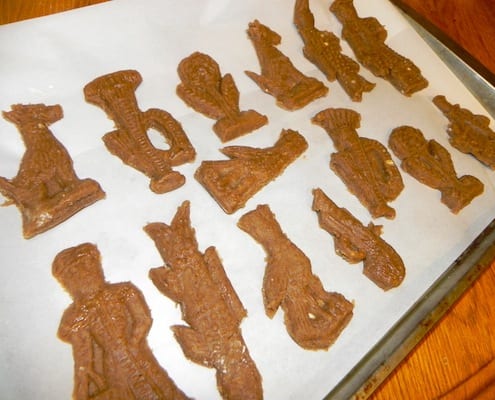A thinly crisp, heavily spiced celebration of a German Christmas tradition.
By Amanda Marsteller
Treasures can often be stowed in forgotten places. My family recently uncovered my great-grandmother’s Spekulatius molds in a long-shuttered cardboard box, and with their reemergence after years unused, I was able to connect with a very German, and very festive tradition. Spekulatius is a classic German Christmas cookie, known for its depth of spices including cinnamon, cloves, nutmeg, and cardamom. The cookies have always been made using sturdy, carved wooden molds that bear ornately detailed figures like animals or costumed men and women. It is the beautiful molds that bear the magic in these cookies, and using them to craft intriguing little characters is a way of paying tribute to the past, as the process is rather difficult, requiring a good smack of elbow grease and equal parts patience to achieve the sacred and crisply browned results.
It is thought that the name Spekulatius might come from the Latin word “Speculum,” for mirror, as the carved molds impart a mirror image onto the cookie dough. These molds are still widely sold in German Christmas markets, although they would undoubtedly be less popular in America because of the effort required in successfully molding the dough, as opposed to using modern cookie cutters and stamps. However, this layer of difficulty is also part of the cookies’ charm; they are native to the Christmas season, when a little extra toil in the kitchen is warranted. My mother told me that she can remember my grandmother and great-grandmother making these cookies together, flouring the molds, rolling the dough out thinly over top, and thwacking and rapping them against the tabletop to force the impression-laden dough back out. So as I tapped and walloped the molds against my own table many years later, I felt a very certain thrill in this quirky process, albeit with a few mutterings of frustration towards my dough. While sprinkling flour may have worked for my family before me, I found it almost impossible to shake the cookie dough out intact without first spraying the molds with a thin layer of cooking oil. That was my Spekulatius salvation.
Also, I found that as the dough is so buttery and sticky, it is imperative to rest and chill it overnight to allow the flavors to mingle and make the dough more firm and manageable. Once the dough relinquishes its fervent hold inside the mold, it is then necessary to trim away the excess with a sharp knife, a delicately detailed process. Perhaps this is what I find so fascinating about these cookies, as they require such a wide range of physical emotions, first violence in their sticky unmolding, then tender concentration as you trace the characters into doughy life. And once baked, they should be rather thin and crisp, with the speckles of spices flowing visibly throughout. There is more than one variety of Spekulatius aside from the spiced version; there are also recipes for Almond and Butter Spekulatius, with the dominant flavors in the name. However, the spiced version is the most authentic, so nothing else would do upon baking my very first batch of Christmas Spekulatius on my own. I hope I would’ve made my German ancestors proud as I stood tapping away at their cookie molds, celebrating our very personal and edible heritage, in the fashion they once did.
PrintGerman Spekulatius Cookies
- Total Time: 1 hour 15 minutes
- Yield: 12-15 cookies 1x
Description
A thinly crisp, heavily spiced celebration of a German Christmas tradition.
Ingredients
- 1 stick butter
- 1 egg
- pinch salt
- 1 cup flour
- 1/2 cup brown sugar
- 3 tablespoons almond flour
- 3 teaspoons cinnamon
- 1 teaspoon nutmeg
- 1 teaspoon allspice
- 1/2 teaspoon ground cloves
- 1 tablespoon milk, plus more for glazing
Instructions
- Mix the butter, egg, and salt together in a large bowl.
- Add half of the flour and all of the rest of the ingredients to the butter bowl, mixing everything together briefly.
- Add the rest of the flour in and knead gently to form a rather sticky dough.
- Cover the dough with plastic and let it rest in the fridge overnight or for 24 hours.
- Preheat oven to 350 degrees F.
- Line a baking sheet with parchment and place it in the fridge to chill.
- Keeping the dough in the fridge, remove a chunk of dough large enough to cover an individual mold.
- Spray the mold with cooking spray or scatter flour over top.
- Place the dough over a mold shape and press down to cover the whole area.
- Roll the dough firmly down into the mold with a rolling pin to a thin layer, preferably with very little sticking above the mold depression.
- Trim some of the excess dough away from the edges so that the dough pops out more easily.
- Tap the top of the mold firmly against the tabletop until the dough falls out.
- With a sharp knife, trace around the edges of the molded cookie until all the excess dough is removed.
- Place the molded cookie on the baking sheet in the fridge and repeat this process until all dough is used.
- Once all cookies are molded, allow them to rest in the fridge another 30 minutes to chill and maintain their shape.
- Lightly brush the cookies with a thin layer of milk to give them a sheen.
- Bake in the oven for 12-15 minutes or until evenly browned and crispy.
Notes
Make the time to chill the dough as well as the molds themselves, the rolling pin you use, the baking sheet, and anything else that will come in contact with the dough to keep everything as cold as possible before baking. This will help the cookies maintain their detailed shapes.
- Prep Time: 1 hour
- Cook Time: 15 mins















I have a question about the brown sugar. Are you using standard US brown sugar (which has molasses)? As I understand it, German “brauner Zucker” is not the same thing, but is simply a type of unbleached sugar).
When we went with store bought Spekulatius spiced cookies I noticed they came from Germany. I’m so glad you shared the recipe. While I don’t know that I will use the more delicately shaped cookie cutters (may go with simple round cutters) I will at least enjoy the benefits of the flavor of the cookies which I treasure. Thanks.
Found them at Aldis ,(on sale) they are just the best , thinking home made might be just the thing ! Thanks ,
Use to eat these in Germany every Christmas Eve when I was stationed there. Have missed them greatly and recently found some at Aldi’s so I got the name, looked them up and found your recipe. So thrilled, can’t wait to make a batch and see if they taste the same.
My husbands family were Dutch bakers. When we found some spekulaas molfs at an antique shop we bought them. I have been making these cookies a few times. I found after dough chilled and put onto moulds. I would run a long piece of dental floss across the top of cookies to remove excess before I turned them out. I have a diffetent recipe and I flour the moulds. Grandkids loved to help.
Yes, you can use a cookie cutter. Just make sure that you roll out the dough really thin like an 1/8″. I roll out the dough when it is cold but not chilled overnight. Then I store the thin slabs in the refrigerator (tightly and well covered, so they don’t dry out) . The next day, I don’t have to wrestle with impossibly firm dough.
Can you make these in cookie cutters? I have some from the 1940’s that might work? I’d love to see whether they taste similar to the Pernicky cookies my mother in law taught me. She was from Europe. Yours sound delicious.
Could you roll these really thin and cut out with cookie cutters? I don’t have the molds. And these sound amazing. Thank you for sharing.
Could I get the recipes for butter and almond spekulatius German crisp cookies.
Wouldn’t chilling the entire filled mold in the freezer for 5 minutes work for allowing the cookies to be released from the mold itself? Seems to me that pre-chilling the wooden mold prior to filling, and then chilling again once filled, would help with releasing as the butter shrinks and loses its stickiness when cold. Thoughts?
I stick of butter is about 113g. Also, a springerle rolling pin can be used instead of the molds.
thank you so much for this recipe… i found these cookies in my local aldi store last year and this year only managed to find one package so was delighted to find this recipe. will be making some soon, but dont have the molds so will be improvising…cant wait!!
Sophie, Hi. I’m reading this recipe and saw your comment. In the US, a stick of butter is 1/2 cup. I don’t know the metric conversion for that; two sticks is 1 cup. I hope that helps.
For us Brits could you explain the weight measurement for ‘a stick of butter’ please.
1 stick of butter, as stated by the other person replying, is 1/2 cup. A Canadian, who is familiar with both, would likely have replied by saying 1/4 pound which might be more quickly clear to someone in the U. K.
one stick of butter, is 112 grams or 4 oz (1/4 of 1 lbs)
After the dough finished resting in refrigerator there was not enough left to bother with bakkng. Next time will post armed guard! My family is famous for eating cookie dough but this is ridiculous!
Dan